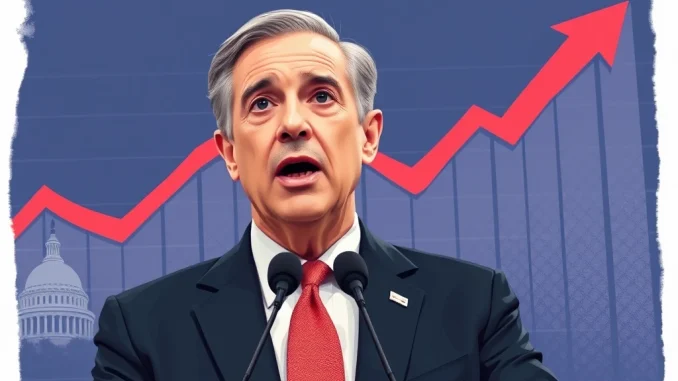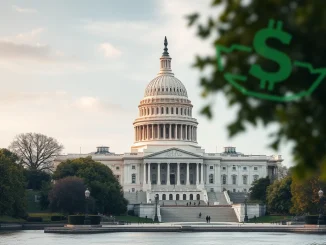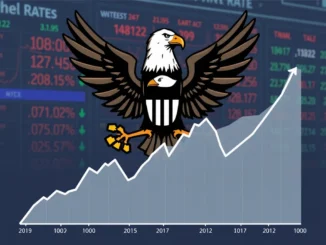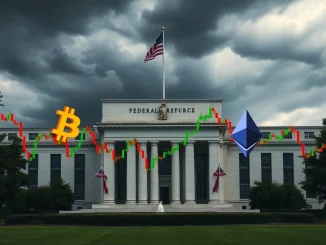
Hold onto your hats, crypto enthusiasts! Federal Reserve Chairman Jerome Powell just dropped a bombshell, and it’s got the markets buzzing. In a recent speech, Powell didn’t mince words, highlighting the very real and urgent risks of both rising unemployment and persistent inflation. This isn’t just Wall Street chatter; it’s a signal that could ripple through every sector, including the volatile world of cryptocurrency. Let’s dive deep into what Powell said, what it means for you, and how it might shape the future of the financial landscape.
Powell’s Double-Edged Sword: Inflation Risk and Unemployment Risk
For those new to the game, the Federal Reserve has a dual mandate: to maintain maximum employment and price stability. Think of it as walking a tightrope between keeping people employed and keeping prices under control. Powell’s recent statements suggest this tightrope is getting increasingly wobbly. He explicitly mentioned the looming threat of simultaneously experiencing inflation risk and unemployment risk. This is a precarious situation, often referred to as stagflation – a scenario economists dread.
What exactly did Powell say?
- Dual Mandate in Focus: Powell reassured that the Fed remains committed to both maximum employment and price stability. He emphasized that these two goals are not in conflict, at least in the Fed’s current view.
- 1970s Comparison Dismissed (For Now): He downplayed comparisons to the economic turmoil of the 1970s, a period marked by high inflation and unemployment. However, the very mention of this risk has markets on edge.
- Trump’s Policies Under the Microscope: Powell stated it would take about a year to fully understand the economic impact of former President Trump’s policies. This introduces a layer of uncertainty, as these policies are still working their way through the economic system.
- Uncertainty Reigns Supreme: The overarching message was uncertainty. Powell stressed that it’s currently “impossible to make a clear judgment” on which policies to adopt, given the complex and evolving economic landscape.
Decoding the Uncertainty: Why is Powell So Cautious?
Powell’s cautious tone stems from a confluence of factors making economic forecasting incredibly challenging right now. Let’s break down some of the key elements contributing to this uncertainty:
- Global Economic Interdependence: The global economy is deeply interconnected. Events in one part of the world can have significant ripple effects elsewhere. Geopolitical tensions, supply chain disruptions, and varying levels of post-pandemic recovery across nations add layers of complexity.
- Lag Effects of Monetary Policy: Monetary policy changes, like interest rate hikes, don’t have an immediate impact. It takes time – often months or even years – for these changes to fully work their way through the economy. This “lag effect” makes it difficult to gauge the current effectiveness of Fed policies and anticipate future outcomes.
- Unpredictable Consumer Behavior: Consumer spending is a massive driver of economic activity. However, consumer behavior is influenced by a multitude of factors – inflation expectations, job security perceptions, savings levels, and even psychological factors. Predicting how consumers will react in the face of economic uncertainty is notoriously difficult.
- Data Delays and Revisions: Economic data is often released with a delay, and initial figures are frequently revised. This means policymakers are often making decisions based on potentially incomplete or outdated information.
Trump Policies: A Year to Unravel the Impact?
Powell’s comment about needing a year to understand the full impact of Trump policies is particularly noteworthy. While he didn’t specify which policies he was referring to, we can infer several potential areas of influence:
| Policy Area | Potential Impact | Uncertainty Factor |
|---|---|---|
| Tax Cuts | Stimulated economic growth initially but could contribute to long-term inflationary pressures and increased national debt. | Long-term effects on government revenue and debt sustainability are still unfolding. |
| Trade Policies (Tariffs) | Disrupted global supply chains, potentially contributing to higher prices for consumers and businesses. | Ongoing trade tensions and adjustments to global trade flows make it hard to quantify the precise impact. |
| Deregulation | Could boost certain sectors but might also lead to increased environmental or financial risks in the long run. | Long-term consequences of deregulation are often difficult to predict and may not be apparent immediately. |
The key takeaway here is that the economic landscape is still adjusting to these policy shifts, and their complete effects are not yet fully understood. This adds another layer of complexity for the Fed as it navigates the current economic waters.
Navigating the Uncertainty: What Does This Mean for Crypto?
So, how does all of this connect to the cryptocurrency world? The macroeconomic environment significantly influences the crypto market. Here’s a breakdown:
- Inflation as a Narrative for Bitcoin: Bitcoin has often been touted as an “inflation hedge.” If inflation risk persists or rises, investors might increasingly turn to Bitcoin and other cryptocurrencies as alternative stores of value, potentially driving up prices.
- Unemployment and Risk Appetite: Rising unemployment risk can impact investor sentiment and risk appetite. In times of economic uncertainty, investors may become more risk-averse and pull back from volatile assets like cryptocurrencies, at least in the short term. However, long-term, economic instability could also push individuals towards decentralized alternatives like crypto.
- Fed Policy and Market Volatility: The Fed’s policy decisions, particularly regarding interest rates, have a direct impact on financial markets, including crypto. If the Fed tightens monetary policy aggressively to combat inflation, it could lead to increased market volatility and potentially dampen enthusiasm for riskier assets. Conversely, a more dovish stance might provide some support to crypto markets.
- Economic Downturns and the Search for Alternatives: Historically, economic downturns have sometimes spurred interest in alternative financial systems. If traditional financial systems face significant challenges due to inflation or unemployment, cryptocurrencies could become more appealing as alternative solutions or investment vehicles.
Actionable Insights: Preparing for Economic Uncertainty
Given Powell’s cautious outlook and the inherent uncertainties in the current economic climate, what can you do to prepare, especially within the crypto space?
- Stay Informed: Keep a close eye on economic data releases, Fed announcements, and geopolitical developments. Knowledge is your best defense in volatile times.
- Diversify Your Portfolio: Don’t put all your eggs in one basket. Diversification across different asset classes, including both traditional and crypto assets, can help mitigate risk.
- Manage Risk Wisely: Understand your risk tolerance and adjust your investment strategies accordingly. Volatility is inherent in the crypto market, and economic uncertainty can amplify it.
- Focus on Long-Term Fundamentals: In times of market turbulence, it’s crucial to focus on the long-term fundamentals of the projects you invest in. Quality projects with strong use cases are more likely to weather economic storms.
- Prepare for Volatility: Expect price swings in the crypto market. Economic uncertainty often leads to increased volatility across all markets.
Conclusion: Navigating the Economic Crossroads
Jerome Powell’s speech serves as a powerful reminder that the economic path ahead is far from certain. The risks of rising unemployment and persistent inflation are real, and the impact of Trump policies is still unfolding. For the crypto world, this uncertainty presents both challenges and opportunities. By staying informed, managing risk, and focusing on long-term fundamentals, you can navigate these economic crossroads and position yourself to thrive, no matter which direction the market winds blow. The key takeaway? Prepare for volatility, and remember that in times of uncertainty, knowledge and adaptability are your greatest assets.



